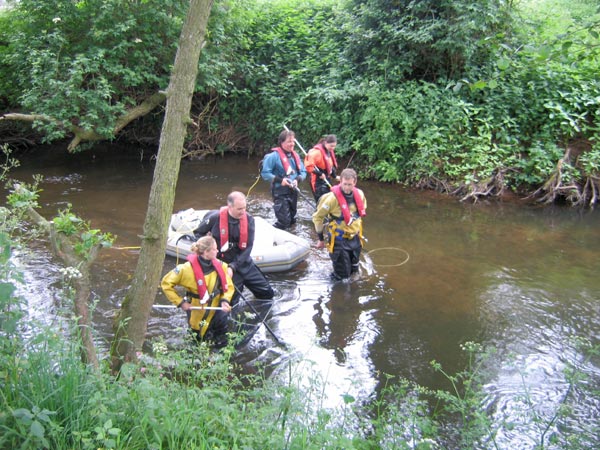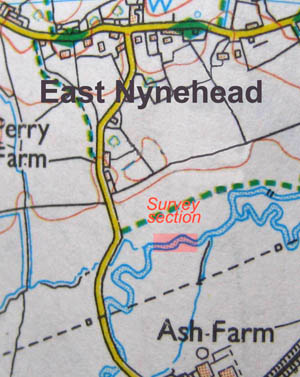FISH SURVEY - RIVER TONE, EAST NYNEHEAD 2009
The image below is of a fish survey being carried out on 28th May 2009 on a 100 metre section of the River Tone at East Nynehead by the Environment Agency. There is a link to the survey data at the foot of the page.

The following is slightly adapted from information very kindly supplied by Iain Harris, the Analysis Reporting Team Leader, Environmental Monitoring Dept.
Electric fishing is a great technique for effectively catching fish without harming them. In the survey [shown in the image above] we were using two ring-anodes to pass a current through the water. The kit in the boat included a generator, control box and holding tank. The control box allows the current and voltage to be altered depending on the water conductivity and depth etc. The circuit is completed by a cathode which is trailed behind the boat. The fish are attracted to the anodes where they become stunned as they get close. Once stunned they are quickly removed by the netters and put in the tank on the boat. The people involved would get a shock if they put their hands in the water, but the net and anode handles are insulated, the anodes have switches which must be held down to pass electricity to the water, and the control box and generator have emergency stop-switches.
 The aproximate section surveyed is shown on the map highlighted pink.
The aproximate section surveyed is shown on the map highlighted pink.
We (the Environment Agency) undertake a large number of fish surveys throughout a variety of 'local' rivers. Our patch extends out to Porlock, down to Yeovil and Sherborne, across to Wootton Bassett and up to Tetbury. We record all the species we catch via a three-run electric-fishing technique. This technique allows an accurate determination of the community size via stats which forward project the depletion of the three runs. The species and sizes we record also allow us to assess the health of the stretch both for local users/groups etc (such as our Nynehead website) right up to Government Directive-driven initiatives (e.g. Water Framework Directive) which need this information to determine ecological status.
Click the link to see the FULL SURVEY DATA which includes the data from the survey carried out last year on 22 May 2008. Here is the original data, slightly modified, for the 2008 Survey and here it is for the 2009 Survey.
